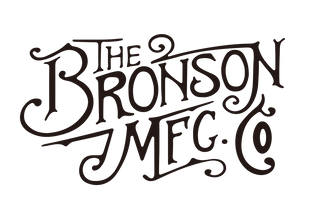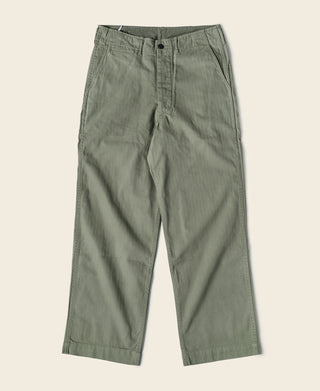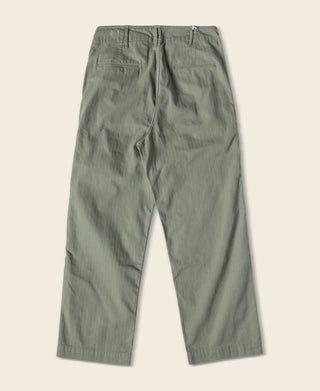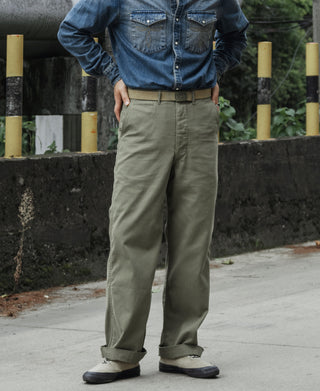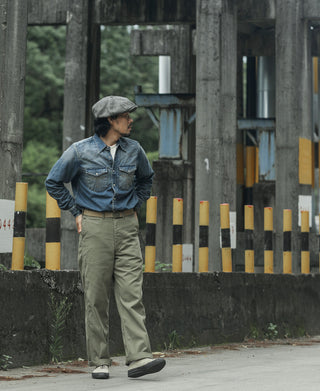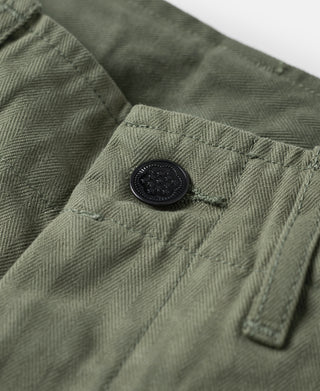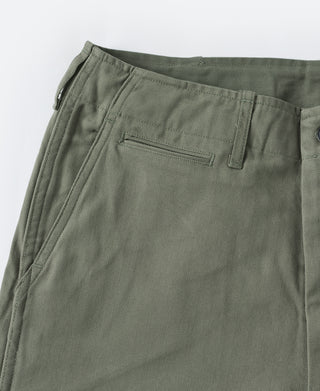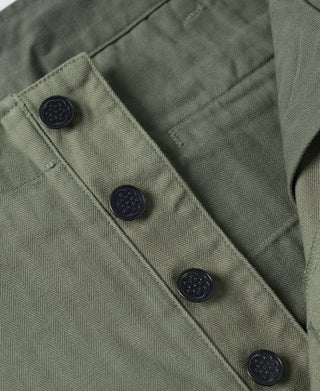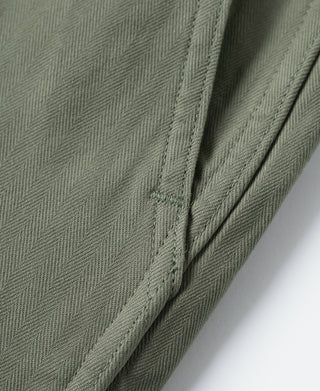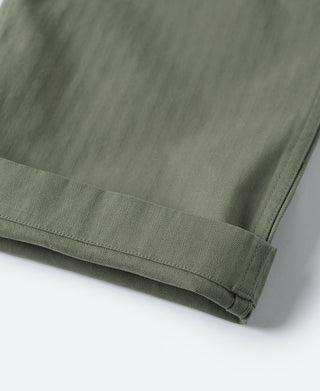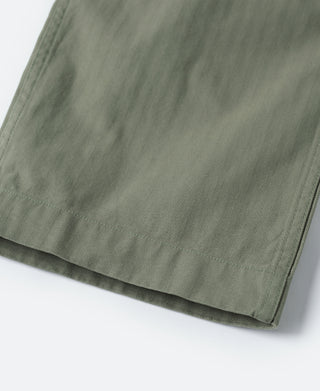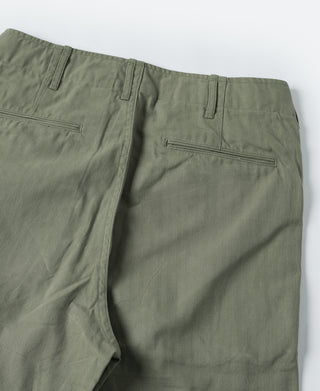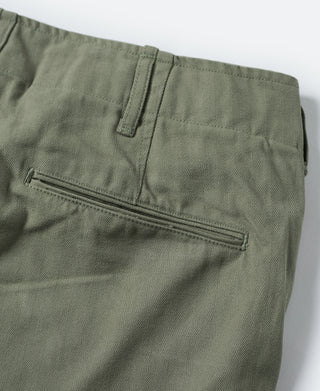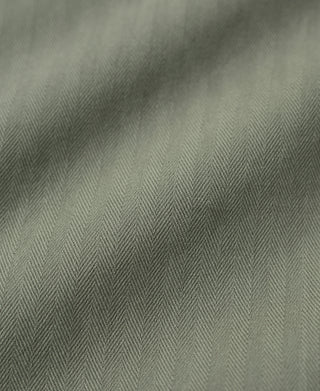Models
- 5' 7" / 170cm and 143lbs / 65kg He wears a size W29.
- 5'10" / 177cm and 154lbs / 70kg. He wears a size W30.
- 5' 10" / 178cm and 160lbs / 73kg. He wears a size W31.
- 5'11” / 180cm and 176lbs / 80kg. He wears a size W32. As the pictures show.
- 5'10" / 177cm and 176lbs / 80kg. He wears a size W34.
- 5'11” / 180cm and 194lbs / 88kg. He wears a size W36.
- 5'11" / 182cm and 209lbs / 95kg. He wears a size W38.
In 1941, the U.S. Army introduced the M-41 split suit as an alternative to the Denim Work Suit. This new suit included a herringbone twill jacket, a pair of herringbone twill pants, and a Daisy Mae Hat. The suit is suitable for civil engineering work and is also used as a summer combat uniform.
The suit was issued for a short period of time, from 1941-1942, and was only made for about a year. Therefore, its circulation in the second-hand market is minimal, and it is one of the very rare styles.
M-41 trousers were labeled "SPEC. NO. 6-254", which is the same as the 1941 version of the Khaki pants of the same period, only replaced with color OD3 herringbone twill fabric.
The U.S. Army began mass adopting this herringbone twill fabric after 1941 as a replacement for the denim fabric that faded easily and was difficult to conceal. This marked a significant milestone in the history of U.S. Army clothing.
- Relaxed fit with a straight leg and high rise.
- Belt loops. Button fly with a buttoned closure. Thirteen stars black brass buttons.
- Two front angled pockets. Right hip coin pocket. Two back welt pockets.
- 10 oz. herringbone twill, 100% cotton.
- Machine washable.
| Model | Height | Weight | Size |
| 1 | 5'7" / 170cm | 143lbs / 65kg | W29 |
| 2 | 5'10" / 177cm | 154lbs / 70kg | W30 |
| 3 | 5'11" / 178cm | 160lbs / 73kg | W31 |
| 4/Shown | 5'11” / 180cm | 176lbs / 80kg | W32 |
| 5 | 5'10" / 177cm | 176lbs / 80kg | W34 |
| 6 | 6'1” / 180cm | 194lbs / 88kg | W36 |
| 7 | 6'1” / 180cm | 209lbs / 95kg | W38 |
| Size | Waist | Hip |
| W29 | 29.1" / 74cm | 40.9" / 104cm |
| W30 | 29.9" / 76cm | 41.7" / 106cm |
| W31 | 30.7" / 78cm | 42.5" / 108cm |
| W32 | 32.7" / 83cm | 43.3" / 110cm |
| W34 | 34.6" / 88cm | 44.9" / 114cm |
| W36 | 36.2" / 92cm | 46.5" / 118cm |
| W38 | 37.8" / 96cm | 48" / 122cm |
| Size | Front Rise | Back Rise |
| W29 | 12.6" / 32cm | 16.5" / 42cm |
| W30 | 12.8" / 32.5cm | 16.7" / 42.5cm |
| W31 | 13" / 33cm | 16.9" / 43cm |
| W32 | 13.2" / 33.5cm | 17.1" / 43.5cm |
| W34 | 13.8" / 35cm | 17.3" / 44cm |
| W36 | 14.2" / 36cm | 17.7" / 45cm |
| W38 | 14.6" / 37cm | 18.1" / 46cm |
| Size | Thigh | Inseam |
| W29 | 26.4" / 67cm | 29.1" / 74cm |
| W30 | 26.8" / 68cm | 29.5" / 75cm |
| W31 | 27.2" / 69cm | 29.9" / 76cm |
| W32 | 27.6" / 70cm | 30.3" / 77cm |
| W34 | 28.3" / 72cm | 30.7" / 78cm |
| W36 | 29.5" / 75cm | 31.1" / 79cm |
| W38 | 30.7" / 78cm | 31.5" / 80cm |
| Size | Length | Leg Opening |
| W29 | 41.3" / 105cm | 18.7" / 47.5cm |
| W30 | 41.7" / 106cm | 18.9" / 48cm |
| W31 | 42.1" / 107cm | 19.1" / 48.5cm |
| W32 | 42.5" / 108cm | 19.3" / 49cm |
| W34 | 43.3" / 110cm | 19.7" / 50cm |
| W36 | 44.1" / 112cm | 20.1" / 51cm |
| W38 | 44.9" / 114cm | 20.5" / 52cm |
In order to best determine fit, it may be helpful to compare our garment’s measurements to a similar garment you already own. Lay your garment on a flat surface and take all measurements from the outside of the garment.
Click here to check out our Garment Measuring Guide.
** If you are still confused, you can Contact Us to help you choose the size. **
- Free shipping on orders $99 (U.S. dollar), Otherwise, a shipping fee of $6.99 will be charged.
- Easy Returns. We provide return labels for your returned packages. Click here for full details. - Return Policy
* All items must be returned in unused, original condition with tags attached.
Free Shipping over $99 + 30-day Returns.
How to Measure? Size Guide
Have questions? Contact Us
Adding product to your cart
Models
- 5' 7" / 170cm and 143lbs / 65kg He wears a size W29.
- 5'10" / 177cm and 154lbs / 70kg. He wears a size W30.
- 5' 10" / 178cm and 160lbs / 73kg. He wears a size W31.
- 5'11” / 180cm and 176lbs / 80kg. He wears a size W32. As the pictures show.
- 5'10" / 177cm and 176lbs / 80kg. He wears a size W34.
- 5'11” / 180cm and 194lbs / 88kg. He wears a size W36.
- 5'11" / 182cm and 209lbs / 95kg. He wears a size W38.
In 1941, the U.S. Army introduced the M-41 split suit as an alternative to the Denim Work Suit. This new suit included a herringbone twill jacket, a pair of herringbone twill pants, and a Daisy Mae Hat. The suit is suitable for civil engineering work and is also used as a summer combat uniform.
The suit was issued for a short period of time, from 1941-1942, and was only made for about a year. Therefore, its circulation in the second-hand market is minimal, and it is one of the very rare styles.
M-41 trousers were labeled "SPEC. NO. 6-254", which is the same as the 1941 version of the Khaki pants of the same period, only replaced with color OD3 herringbone twill fabric.
The U.S. Army began mass adopting this herringbone twill fabric after 1941 as a replacement for the denim fabric that faded easily and was difficult to conceal. This marked a significant milestone in the history of U.S. Army clothing.
- Relaxed fit with a straight leg and high rise.
- Belt loops. Button fly with a buttoned closure. Thirteen stars black brass buttons.
- Two front angled pockets. Right hip coin pocket. Two back welt pockets.
- 10 oz. herringbone twill, 100% cotton.
- Machine washable.
| Model | Height | Weight | Size |
| 1 | 5'7" / 170cm | 143lbs / 65kg | W29 |
| 2 | 5'10" / 177cm | 154lbs / 70kg | W30 |
| 3 | 5'11" / 178cm | 160lbs / 73kg | W31 |
| 4/Shown | 5'11” / 180cm | 176lbs / 80kg | W32 |
| 5 | 5'10" / 177cm | 176lbs / 80kg | W34 |
| 6 | 6'1” / 180cm | 194lbs / 88kg | W36 |
| 7 | 6'1” / 180cm | 209lbs / 95kg | W38 |
| Size | Waist | Hip |
| W29 | 29.1" / 74cm | 40.9" / 104cm |
| W30 | 29.9" / 76cm | 41.7" / 106cm |
| W31 | 30.7" / 78cm | 42.5" / 108cm |
| W32 | 32.7" / 83cm | 43.3" / 110cm |
| W34 | 34.6" / 88cm | 44.9" / 114cm |
| W36 | 36.2" / 92cm | 46.5" / 118cm |
| W38 | 37.8" / 96cm | 48" / 122cm |
| Size | Front Rise | Back Rise |
| W29 | 12.6" / 32cm | 16.5" / 42cm |
| W30 | 12.8" / 32.5cm | 16.7" / 42.5cm |
| W31 | 13" / 33cm | 16.9" / 43cm |
| W32 | 13.2" / 33.5cm | 17.1" / 43.5cm |
| W34 | 13.8" / 35cm | 17.3" / 44cm |
| W36 | 14.2" / 36cm | 17.7" / 45cm |
| W38 | 14.6" / 37cm | 18.1" / 46cm |
| Size | Thigh | Inseam |
| W29 | 26.4" / 67cm | 29.1" / 74cm |
| W30 | 26.8" / 68cm | 29.5" / 75cm |
| W31 | 27.2" / 69cm | 29.9" / 76cm |
| W32 | 27.6" / 70cm | 30.3" / 77cm |
| W34 | 28.3" / 72cm | 30.7" / 78cm |
| W36 | 29.5" / 75cm | 31.1" / 79cm |
| W38 | 30.7" / 78cm | 31.5" / 80cm |
| Size | Length | Leg Opening |
| W29 | 41.3" / 105cm | 18.7" / 47.5cm |
| W30 | 41.7" / 106cm | 18.9" / 48cm |
| W31 | 42.1" / 107cm | 19.1" / 48.5cm |
| W32 | 42.5" / 108cm | 19.3" / 49cm |
| W34 | 43.3" / 110cm | 19.7" / 50cm |
| W36 | 44.1" / 112cm | 20.1" / 51cm |
| W38 | 44.9" / 114cm | 20.5" / 52cm |
In order to best determine fit, it may be helpful to compare our garment’s measurements to a similar garment you already own. Lay your garment on a flat surface and take all measurements from the outside of the garment.
Click here to check out our Garment Measuring Guide.
** If you are still confused, you can Contact Us to help you choose the size. **
- Free shipping on orders $99 (U.S. dollar), Otherwise, a shipping fee of $6.99 will be charged.
- Easy Returns. We provide return labels for your returned packages. Click here for full details. - Return Policy
* All items must be returned in unused, original condition with tags attached.
